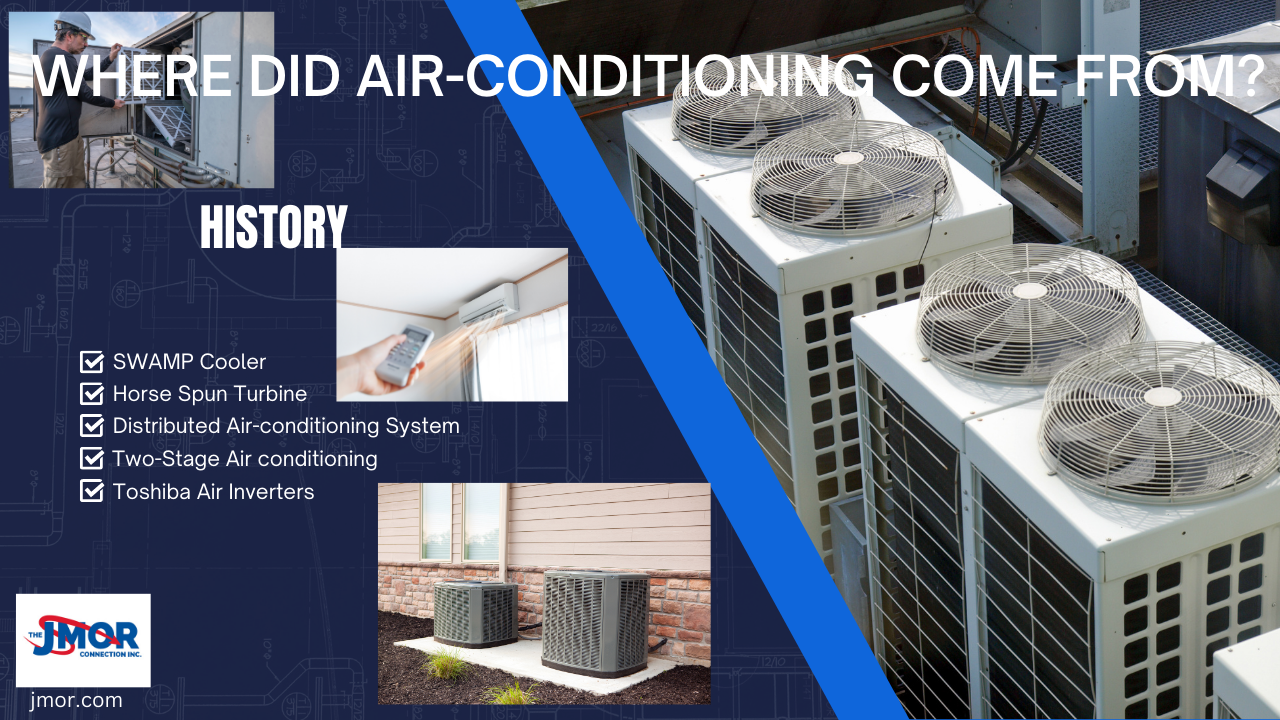Whether it’s 103 degrees Fahrenheit or a bit humid, an air conditioner today has become more than a luxury but a necessity for our lives. It started with Egypt’s first type of cooler, the swamp cooler. Many people believe the name came from what it would smell like if you didn’t have it serviced regularly. A Swamp Cooler works by using hot, dry air and using it to evaporate the water from its pads which turns into cooler air. Since Swamp Coolers operate by taking hot, dry air, they cannot cool swamps.
Swamp Coolers trace back to when pharaohs used jars of water, ponds, and pools to cool an area. Many homes were kept cool initially by installing awnings and windows. Water chutes were also installed in buildings to help lower their temperature. These innovations continued to help many areas with hot and dry climates stay cool.
If we fast forward a few hundred years to around the 16 or 17th century, more inventors and scientists emerged to refine the technology, such as Leonardo Di Vinci and Blaise Pascal, which helped lay the initial groundwork for the first air conditioner. One of the patented models for air-conditioning relied on a horse to spin a turbine that, in turn, melted ice and cooled the area via evaporation.
Willis Carrier, an American Engineer 1902, invented the first modern refrigerated air conditioner prototype. Shortly after Willis Carrier had a successful concept for the standard air-conditioner, he opened Carrier Engineering business. This company was the first to make a distributed air conditioner; throughout the 20th century, they improved, grew in popularity, and became more affordable.
By the 1950s, most homeowners could start to afford their air-conditioning system, and the first unit was installed in Brooklyn, NY. Did you know that Milam Building in San Antonio was the first building ever to have central air-conditioning in the United States?
Air-Conditioners have made life much more enjoyable, but how do they work? Central air-conditioning systems are comprised of six primary parts to allow them to operate. The first part that many of you are familiar with is the thermostat. This is where you set the temperature once, program it via your internet-enabled phone, and the device turns on/off your unit at respective temperatures. An outside unit houses the fan, condenser coil, and compressor. The indoor unit may be your furnace or fan coil, which also has the evaporator A coil, enabling the cool air to circulate. An expansion valve regulates the amount of refrigeration going into the evaporator coil. Last but not least is the distribution ductwork that allows air to be pulled in and circulated back to the various room ducts.
First, you program your thermostat or set it manually to your desired temperature. When the temperature in your building is higher than the set temperate, the internal air handler condenser fan and the outside compressor turn on. The compressor then starts pumping a chemical called refrigerant through the system used because of its low boiling point. Refrigerants constantly change from liquid to gas to move heat from inside your home to the outdoors.
The refrigerant enters the compressor as a low-pressure, low-temperature vapor or gas. Then after being compressed, it leaves as a high-temperature, high-pressure vapor or gas. Next, it travels through the condenser coils, where the vapor condenses into a liquid and is cooled with the fan’s air. Following this, it leaves the condenser as a medium-temperature, high-pressure liquid and enters the metering device inside, and the thermal expansion value is used. A pin inside the valve adjusts the flow rate of refrigerant respective to the temperature at the evaporator end using a sensing bulb. As expected, it flows through the value, dramatically dropping the pressure and releasing a low-temperature, low-pressure liquid/vapor mix. The lower pressure allows room-temperature air to boil the refrigerant. The chilled refrigerant is passed through the A-Frame evaporator coil, and the blower starts circulating air throughout the building.
The room-temperature air is pulled through the return duct and passes through the filter to remove debris particles. The heat from the air is absorbed into the refrigerant inside the evaporator coil, dispensing cool air out of the supply registers. As the air passes over the coil, the refrigerant is boiled and evaporates back into vapor. Thus, it exists as a low-temperature, low-pressure gas and is sent back to the condenser to dissipate the collected indoor heat, and the cycle starts over again.
In 1980 Toshiba invented the inverter, a device to cool or heat a room to a desired temperature quickly. With an inverter, the unit can continuously regulate cooling and heating by alternating the compressor’s speed in response to cooling demands. Toshiba inverters work with two types of technology PAM and PWM. PAM means Pulse Amplitude Modulation or the ability to yield the highest power levels. PWM is Pulse Width Modulation, which keeps rooms at their ideal temperature with the most optimum energy use.
Around 2021 two-stage air-conditioning systems came out, and although they are more expensive if installed and used correctly, they will save owners money. A two-stage air-conditioner may cost the owner anywhere from $500 to, 2500 or more at the initial installation. These systems have a low and high setting, last longer, and are much more efficient. A two-stage air-conditioning system will run at low speed when the room temperature is similar to the thermostat. However, the compressor will run at high speed if the room temperature is significantly warmer than the thermostat.
Thus air-conditioners have evolved from the stone age from hanging cloth to absorb humidity to advanced two-stage air conditioners. Also, thanks to Toshiba with inverters and changing the motor speed, we can affect whether it gets warmer or cooler.






